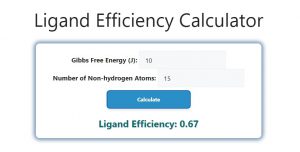About Ligand Efficiency Calculator (Formula)
The Ligand Efficiency Calculator is an essential tool for researchers and chemists involved in drug design and discovery. Ligand efficiency is a key metric that helps in evaluating the effectiveness of a ligand in binding to its target, usually a protein or receptor. By calculating ligand efficiency, scientists can compare different compounds and make informed decisions on which ligands are more promising for further development. This calculator considers the Gibbs Free Energy of binding and the number of non-hydrogen atoms in the ligand, providing a straightforward measure of efficiency that can guide the optimization process.
Formula
The formula for calculating Ligand Efficiency is:
Ligand Efficiency (EL) = Gibbs Free Energy (G) / Number of Non-hydrogen Atoms (N)
Where:
- Gibbs Free Energy (G) represents the energy associated with the binding of the ligand to its target.
- Number of Non-hydrogen Atoms (N) indicates the structural complexity of the ligand.
How to Use
Using the Ligand Efficiency Calculator is straightforward. Follow these steps:
- Determine Gibbs Free Energy: Calculate or obtain the Gibbs Free Energy value for the ligand. This value is often derived from experimental data or computational predictions.
- Count Non-hydrogen Atoms: Identify the ligand structure and count the number of non-hydrogen atoms present. This includes carbon, nitrogen, oxygen, sulfur, and any other relevant elements.
- Input Values: Enter the values for Gibbs Free Energy and the number of non-hydrogen atoms into the calculator.
- Calculate Ligand Efficiency: Use the formula to compute the Ligand Efficiency, which will help assess the ligand’s effectiveness relative to its size.
Example
Suppose you have a ligand with a Gibbs Free Energy of -10 kcal/mol and it contains 15 non-hydrogen atoms.
Using the formula:
Ligand Efficiency (EL) = Gibbs Free Energy (G) / Number of Non-hydrogen Atoms (N)
Ligand Efficiency (EL) = -10 / 15
Ligand Efficiency (EL) = -0.67 kcal/mol/atom
In this case, the ligand has a ligand efficiency of -0.67, indicating its binding strength relative to its size.

FAQs
- What is ligand efficiency?
Ligand efficiency is a measure of how effectively a ligand binds to its target relative to its size, calculated as the Gibbs Free Energy per non-hydrogen atom. - Why is ligand efficiency important?
It helps researchers prioritize compounds that offer a better balance between binding strength and molecular complexity, streamlining drug discovery efforts. - How is Gibbs Free Energy measured?
Gibbs Free Energy can be determined through experimental methods like isothermal titration calorimetry or estimated using computational modeling. - Can ligand efficiency predict drug efficacy?
While it provides useful insights, ligand efficiency should be considered alongside other factors like pharmacokinetics and toxicity in drug development. - What are non-hydrogen atoms?
Non-hydrogen atoms in a ligand refer to all atoms except hydrogen, such as carbon, nitrogen, and oxygen, which contribute to the ligand’s structure. - Is there an optimal ligand efficiency value?
An ideal value varies depending on the target and specific context, but higher (less negative) efficiency values generally indicate better ligand performance. - Can I use this calculator for any ligand?
Yes, the calculator can be applied to any ligand as long as you have the Gibbs Free Energy and the count of non-hydrogen atoms. - What if I don’t have the Gibbs Free Energy value?
You may need to conduct experiments or simulations to determine this value if it’s not readily available from literature. - How does ligand efficiency influence drug design?
It guides the selection of lead compounds by indicating which ligands have optimal binding properties for further development. - Can ligand efficiency be improved?
Yes, through medicinal chemistry techniques, researchers can modify ligands to enhance their efficiency by optimizing structure or binding characteristics. - How is this calculator different from others?
This calculator specifically focuses on ligand binding properties, allowing for direct comparisons of compounds in drug discovery. - Can I input multiple ligands into the calculator?
Generally, the calculator is designed for one ligand at a time, but you can compare results across different ligands sequentially. - Is there a relationship between ligand efficiency and affinity?
Yes, ligand efficiency is often correlated with affinity; more efficient ligands tend to have better binding affinities. - What software tools are available for ligand efficiency calculations?
Various computational chemistry software tools provide built-in features for ligand efficiency analysis alongside other metrics. - Does this calculator account for steric hindrance?
No, the basic calculation does not account for steric effects, which should be evaluated separately during the ligand design process. - How can I visualize ligand efficiency?
Results can be visualized using graphs comparing ligand efficiency across different compounds or plotted against other parameters. - Can ligand efficiency vary with different targets?
Yes, ligand efficiency may differ depending on the target due to varying binding sites and interactions. - What should I consider when optimizing ligand efficiency?
Consider the ligand’s binding mechanism, molecular size, flexibility, and interactions with the target when optimizing. - Are there benchmarks for ligand efficiency?
Some studies provide benchmarks or ranges for efficiency values that can help evaluate ligand performance. - How often should I calculate ligand efficiency during the design process?
It’s beneficial to calculate ligand efficiency throughout the design process to track progress and guide modifications.
Conclusion
The Ligand Efficiency Calculator is a powerful tool for researchers focused on drug discovery and design. By calculating ligand efficiency using Gibbs Free Energy and the number of non-hydrogen atoms, scientists can optimize their compounds and prioritize those with the best potential for success. Regular use of this calculator can enhance the efficiency of drug development, ultimately leading to more effective treatments and improved patient outcomes.
